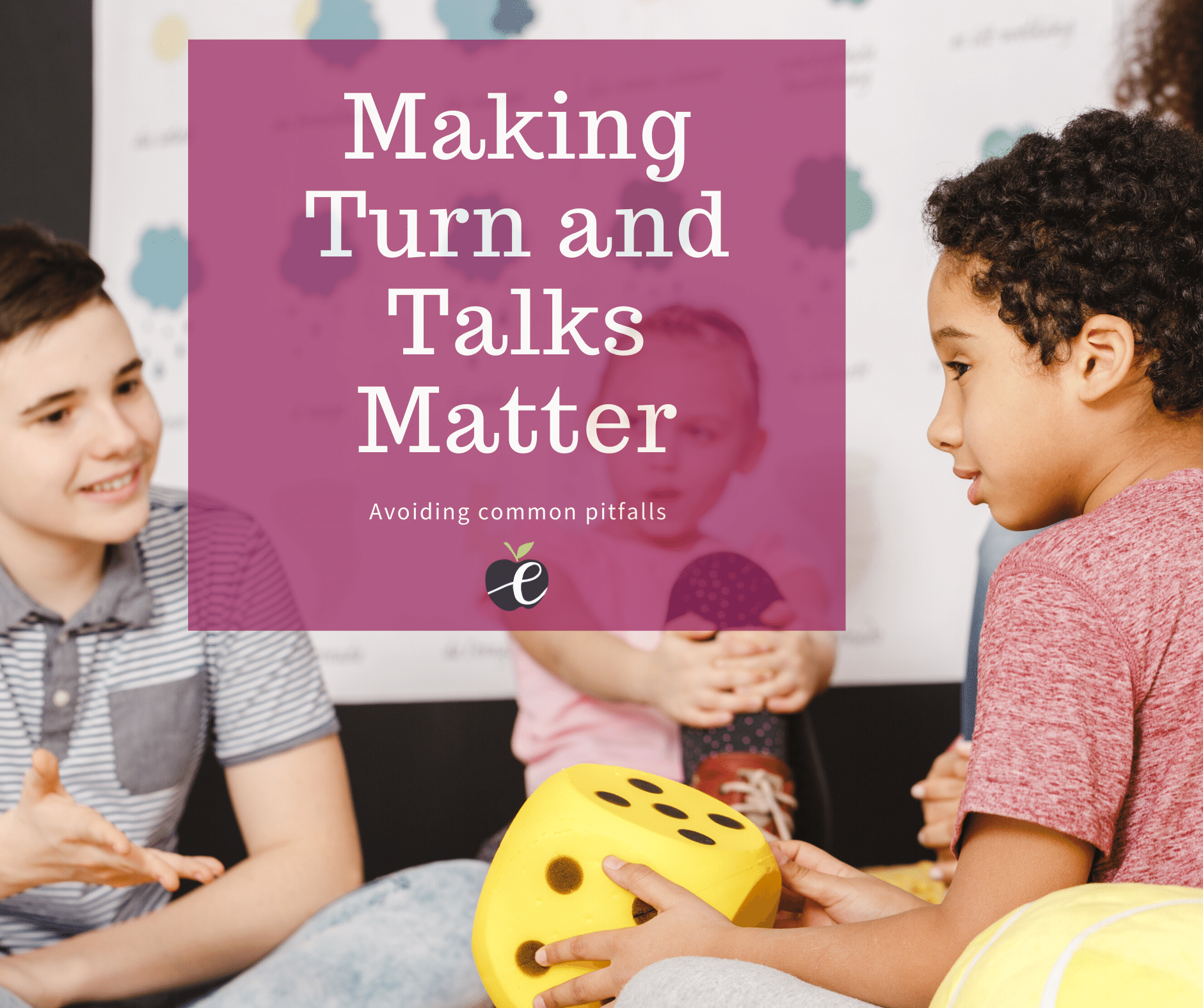
17 Feb 3 Reasons Turn and Talks Don’t Work
“Teachers have been led to believe it’s good practice to have students work in groups or pairs, to boost learning and critical thinking. But too often, students get little or no benefit.”
This quote, from a recent article in Forbes Magazine, at first glance, had me steaming, as partner talk is a pillar of what I find necessary in elementary math classrooms. But then, I read further and agreed with much of the author’s perspective about what is actually happening in turn and talks vs. the intended outcome. Natalie Wexler goes on to suggest that although the intention is for students to learn from one another, often we the opposite. She goes on to say,
Researchers looked at 71 studies on peer interaction in the United States and Great Britain, where there’s similar pressure to use group and pair work. The studies show that students can learn more from interacting with peers than from working independently, but just telling them to “turn and talk” isn’t enough. Teachers need to give kids guidelines that require them to debate and negotiate, researchers concluded—for example, “Make sure you understand your partner’s perspective.”
So, although I agree with these findings, I must take a moment to counter a few of Ms. Wexler’s ideas, so bear with me for a moment as she goes on to explain how because of the shortcomings that happen with turn and talks, she suggests it is better if teachers find other strategies.
Ms. Wexler: to set the record straight, although your observations are correct, that much of the time turn and talk isn’t meeting the set intentions, I don’t believe kids are incapable of having meaningful conversations, new teachers are fully capable of managing turn and talks, and writing isn’t the only way to include everyone in the learning. I also think you miss the boat in terms of research. John Hattie’s visible learning research shows reciprocal teaching to have a .74 effect size. This is MORE effective than most of our current teaching practices. In your article, you refer to researchers who suggest that students can have a meaningful conversation, but they need guidelines that require them to debate and negotiate…so the solution isn’t GIVE UP. The solution is to UP OUR TEACHING. I’d also like to introduce you to the work of Elham Kazemi, Allison Hintz, Suzanne Chapin, Catherine O’Connor, Nancy Anderson, Dr. Karen Fuson, and Kassia Wedekind whom’s goals are the same as mine: teach them how to talk to each other.
Our students CAN have meaningful conversations, they just need meaningful structures, practice, and coaching.
Partner talk has SO many benefits, such as :
- It provides the opportunity for the rehearsal of ideas.
- It builds community. The teacher isn’t the only one who can help me.
- It increases active engagement.
But, it can quickly not meet these goals and lead to teachers giving up when
- Students don’t’ understand their role in turn and talks
- Students aren’t partnered well, so, therefore, they aren’t moving along their learning path
- Routines, rationale, and expectations are not set up and held up.
When we try things as teachers, we are counting on them going well if we are going to continue them. We all know there isn’t any ‘extra’ time in teaching so if something doesn’t work, we tend to stop doing it. However, we also know that anything worth doing is worth doing well. We have to coach and train students and be diligent about the training if we want it to work.
It is no wonder we are frustrated by turn and talks when we try them and students either
- don’t’ talk
- talk at each other
- won’t stop talking and get off task
- don’t stay on topic
But, what if we worked on the first three reasons turn and talk is worthwhile, and then build in structures and routines to avoid the second and third lists above? What if we acknowledged partner talk isn’t working and TEACH THEM TO DO IT BETTER?
Partner talk provides the opportunity for rehearsal.
This means it allows students to try out their ideas, explain their thinking, rehearse someone else’s thinking, and be impacted by another’s thinking. But, if students don’t know their roles, this can all fall apart. Students have to know who their partner is, when it’s their turn to talk, how to start a conversation, how to respond to someone else who spoke first, how to explain thinking so someone else understands, and how to wrap up a conversation before it goes off track.
Sheesh! See, what we think is natural for students, really isn’t. All of the above have to be taught explicitly.
Once these structures are in place, students have a place to try on their thinking. ALL students, not just the one being called upon. They get to repeat reasoning, add on to someone’s thinking and have process time. Our English Language Learners need this repetition. When given the right supports, such as sentence stems, language and content understanding can be significantly boosted.
In an article by ASCD,
We are reminded of Bakhtin’s (1981) realization: “The world in language is half someone else’s. It becomes ‘one’s own’ only when the speaker populates it with his own intention, his own accent, when he appropriates the word, adapting it to his own semantic and expressive intention” (pp. 293–294). In other words, if students aren’t using the words, they aren’t developing academic discourse. As a result, we often think we’ve done a remarkable job teaching students and then wonder why they aren’t learning. The key is for students to talk with one another, in purposeful ways, using academic language.
Partner talk provides the opportunity to build community.
The teacher can’t be the only hero or helper in the room. When students start to understand that their peers can help them, impact their thinking, etc. the classroom becomes a safe place for mathematicians. The teacher’s line at her desk becomes shorter because students have been trained HOW to help, coach, etc. Are your students not very good at helping each other, and just telling answers? Don’t give up, TEACH UP. They just need better coaches (aka..you).
Partner talk increases engagement.
Of course, what we know, is that partner talk increases engagement WHEN students are taught HOW to have equitable conversations. I rely on this mantra daily, “EVERY VOICE, EVERY DAY.” Who is hiding in my room? Who is trying to be ignored? Who has gone the entire class period not having to use their voice at all??? If coached well, we can fix this and make learning way more engaging and effective. When students have identified roles (speaker, listener), supports for talking (stems, and quality dialogue questions, not just call and response questions), conversations thrive and keep all students ‘in the math, ‘ instead of passive bystanders waiting for the teacher to tell them what, when, where and why.
When we provide students with structure, we provide them with safe and secure places for conversations. Eventually, the structures allow the community to rise up and students naturally begin talking to and with each other in equitable ways. According to Kimberly Hufferd-Ackles, Karen C. Fuson, Miriam Gamoran Sherin’s research, this is the highest form of math talk.
I can obviously talk about this topic for a while, but let me leave you with a few action steps to get you on your way to having more meaningful partner talk.
- Provide structures for students to talk better with each other. Who talks first, who responds, how do they respond?
- Give students something worthwhile to talk about. Yes, no, one-word answers aren’t opportunities for quality dialogue.
- Provide sentence frames or stems– but teach them explicitly when the frames are appropriate for the conversation.
- Get peer data. Want to know if your partner talk is effective or if it is how Ms. Wexler describes it in her article above? Invite a peer, coach, or other trusted source into your room to sit with students. Have them collect data on partnerships. Are there dominators? Are students able to use the frames? Is it impacting the other partner– meaning do partners even notice when their work is different? I do this in a structure called Learning Labs and I find the data to be invaluable, timely, and actionable. What you think is happening around the room, is not always what is actually happening. You can learn more here, or if you are attending NCSM this year, I will be presenting a session on this very topic.
Need more support? I gotcha covered. Head over to www.empowerlearngrow.com/partnertalk/ to get FREE resources to help you structure talk and provide stems. You’ll see videos of me norming students, but also, right now I have TWO MINI COURSES OPEN to help you, your team or your staff walk STEP BY STEP through norming, selecting, coaching your partners to having effective turn and talks. They aren’t doing what you want? Let’s level up, by TEACHING UP and in my courses, you get STEP BY STEP instructions to make it work.
Get Partner Talk Freebies Here



Sorry, the comment form is closed at this time.